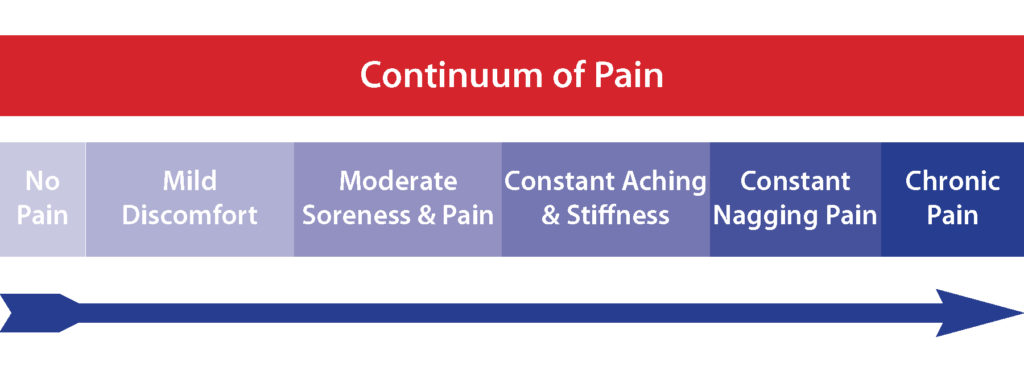Pain is a pervasive problem across industries, and its negative effects extend from the unfortunate employees to the company as a whole. You may have noticed the amount of pain your employees feel gradually growing worse and worse. Now is the time to not only stop the ever-growing pain continuum, but to reverse its effects. How can you ensure your employees are pain-free in your company?
What is the Pain Continuum?
Pain exists on a continuum that represents the gradual changes in intensity. People will generally start off with no pain at all, but eventually they may start to notice some mild discomfort after sitting at their desk too long. It gradually goes from moderate to constant to a severe, chronic pain that desperately needs attention.
- No Pain
- Mild Discomfort
- Moderate Soreness
- Constant Aching & Stiffness
- Constant Nagging Pain
- Severe Chronic Pain
With proper care, the pain will gradually decrease back down the spectrum, ideally reaching the “No Pain” zone once more. But the longer the pain is left to fester, the more care it will need to get back to normal. Regardless of what has caused the pain, the workplace is affected. Addressing pain issues at the earliest stages within the pain continuum is the most cost effective and typically resolves quickly.
How Pain Affects Your Company
Workers across industries experience various levels of pain, generally from musculoskeletal disorders (MSDs) or injuries. Health conditions and age also contribute to the pain your employees endure.
MSDs affect 25.5 million people in the US, most commonly in the back, neck, and upper limbs. They account for 29% of all US workplace injuries and one third of all workers’ compensation claims, and directly cost companies $20 billion per year, not to mention indirect costs five times that number. While other injuries require about 8 days away from work, MSDs require an average of 11 days away from work.
Pain – whether from MSDs, injuries, or health – have far-reaching effects on companies. They lead to presenteeism and absenteeism. Some studies estimate that presenteeism costs US employers between $150 billion and $250 billion per year. In one study, employees admitted to being unproductive 57.5 working days of the year, meaning employees are fully productive only 75% of the time. When the pain is too debilitating, employees miss work entirely. Absenteeism is estimated to cost US employers around $150 billion per year.
When employees are at work, pain prevents them from being as productive as they can be. If they miss work due to the pain, employees often rush to catch up once they return. In an effort to relieve the pain and be able to keep working, many employees turn to medication usage.
Ultimately, the pain can result in lowered employee morale. Employees can become dissatisfied with a corporation in cases of muscular pain. This may be due to the work environment and how it contributed to the pain. Or it may be due to how accommodating or responsive an employer is in helping the suffering employee get back on track. Low morale and job satisfaction are contagious, and one employee’s dissatisfaction can quickly spread. Lowered morale can lead to employee turnover and more costs for the company to endure.
How to Prevent and Treat the Pain
You know what they say: Prevention is the best medicine. Your company would do well with a culture of health and an ergonomic environment. Make sure your workstations are comfortable and that chairs are ergonomic. You may consider investing in sit/stand mechanisms for the current workstations to increase workstation flexibility and improve daily ergonomic function. This helps to provide employees with the resources to be more accountable for their own health in the workplace. Wellness programs can go a long way in keeping your employees healthy. Proper training is also vital for all employees.
But pain will inevitably develop, and it’s important to be prepared for that. One of the best investments you can make is in on-site deep tissue therapy. DORN Companies provide a variety of on-site treatment programs that will help your employees reduce or eliminate the pain, as well as preventing the higher levels of pain from developing.
The PainRelief™™ program provides intervention and prevention. If a worker already has any level of pain, our therapists will be able to stop the pain from getting worse, relieve the pain, and ultimately eliminate it. The PainRelief™ program provides intervention and treatment for scenarios where pain is on the higher end of the pain continuum. PainRelief™ also is an important preventative measure, ensuring pain doesn’t arise in the first place.
DORN’s Clinical Lead, Rainene Miller, adds:
In addition to relieving pain, another important factor in the DORN treatment protocol is to encourage employee involvement in the improvement and management of their personal health and wellness. This educational component is both empowering and long lasting throughout the employee population.
The PeakPerformance™™ program is focused on maintenance. Keep your workers in great shape throughout the year instead of waiting until there is a problem. It’s always ideal to fix minor issues along the way before they grow worse. Rainene Miller explains:
The proactive and preventative measures of PeakPerformance™ have a significant impact in all the areas where employers commonly look to for cost savings when addressing employee health and wellness.
Pain doesn’t just hurt the employees – it also hurts the company. With the right mindset and tools, you will be able to help your employees live pain-free. Invest in quality ergonomics, wellness programs, and on-site therapy programs. You’ll soon see your pain continuum gradually drop off from severe chronic pain to no pain at all.


